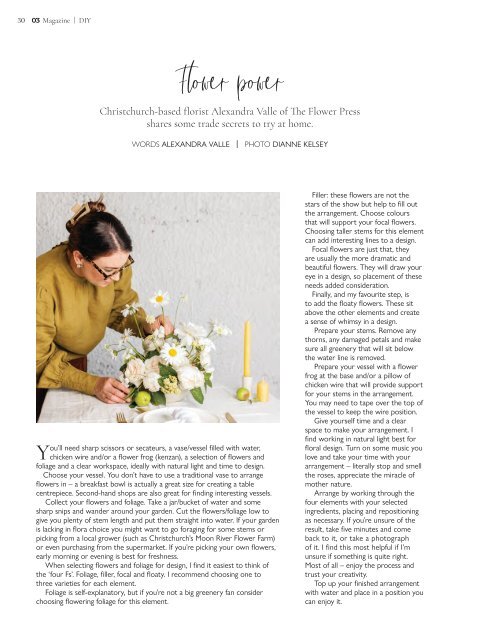03 Magazine: February 08, 2023
Create successful ePaper yourself
Turn your PDF publications into a flip-book with our unique Google optimized e-Paper software.
30 <strong>Magazine</strong> | DIY<br />
Flower power<br />
Christchurch-based florist Alexandra Valle of The Flower Press<br />
shares some trade secrets to try at home.<br />
WORDS ALEXANDRA VALLE | PHOTO DIANNE KELSEY<br />
You’ll need sharp scissors or secateurs, a vase/vessel filled with water,<br />
chicken wire and/or a flower frog (kenzan), a selection of flowers and<br />
foliage and a clear workspace, ideally with natural light and time to design.<br />
Choose your vessel. You don’t have to use a traditional vase to arrange<br />
flowers in – a breakfast bowl is actually a great size for creating a table<br />
centrepiece. Second-hand shops are also great for finding interesting vessels.<br />
Collect your flowers and foliage. Take a jar/bucket of water and some<br />
sharp snips and wander around your garden. Cut the flowers/foliage low to<br />
give you plenty of stem length and put them straight into water. If your garden<br />
is lacking in flora choice you might want to go foraging for some stems or<br />
picking from a local grower (such as Christchurch’s Moon River Flower Farm)<br />
or even purchasing from the supermarket. If you’re picking your own flowers,<br />
early morning or evening is best for freshness.<br />
When selecting flowers and foliage for design, I find it easiest to think of<br />
the ‘four Fs’. Foliage, filler, focal and floaty. I recommend choosing one to<br />
three varieties for each element.<br />
Foliage is self-explanatory, but if you’re not a big greenery fan consider<br />
choosing flowering foliage for this element.<br />
Filler: these flowers are not the<br />
stars of the show but help to fill out<br />
the arrangement. Choose colours<br />
that will support your focal flowers.<br />
Choosing taller stems for this element<br />
can add interesting lines to a design.<br />
Focal flowers are just that, they<br />
are usually the more dramatic and<br />
beautiful flowers. They will draw your<br />
eye in a design, so placement of these<br />
needs added consideration.<br />
Finally, and my favourite step, is<br />
to add the floaty flowers. These sit<br />
above the other elements and create<br />
a sense of whimsy in a design.<br />
Prepare your stems. Remove any<br />
thorns, any damaged petals and make<br />
sure all greenery that will sit below<br />
the water line is removed.<br />
Prepare your vessel with a flower<br />
frog at the base and/or a pillow of<br />
chicken wire that will provide support<br />
for your stems in the arrangement.<br />
You may need to tape over the top of<br />
the vessel to keep the wire position.<br />
Give yourself time and a clear<br />
space to make your arrangement. I<br />
find working in natural light best for<br />
floral design. Turn on some music you<br />
love and take your time with your<br />
arrangement – literally stop and smell<br />
the roses, appreciate the miracle of<br />
mother nature.<br />
Arrange by working through the<br />
four elements with your selected<br />
ingredients, placing and repositioning<br />
as necessary. If you’re unsure of the<br />
result, take five minutes and come<br />
back to it, or take a photograph<br />
of it. I find this most helpful if I’m<br />
unsure if something is quite right.<br />
Most of all – enjoy the process and<br />
trust your creativity.<br />
Top up your finished arrangement<br />
with water and place in a position you<br />
can enjoy it.


















